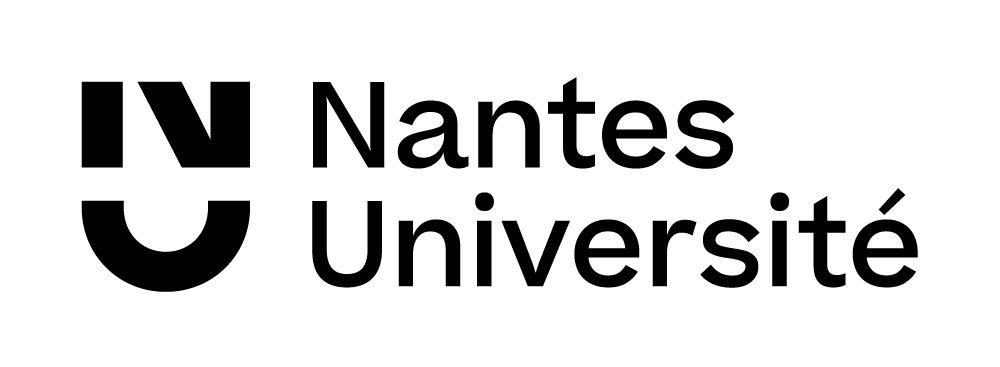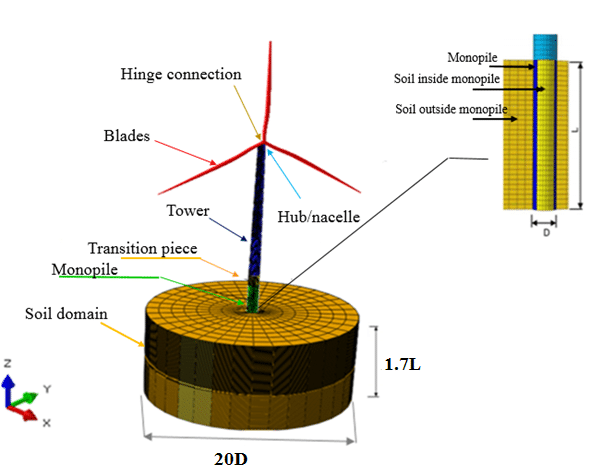
Background
Monopiles are the most common form of foundations for offshore wind turbines (OWTs). Monopile foundations support slender flexible tower and they withstand aerodynamic and hydrodynamic forces due to wind and waves respectively. In order to reduce their cost, OWTs must have a powerful generator and a minimum overall weight. This has the consequence of making the structure of the wind turbine sensitive to dynamic loadings even at low frequencies.
Scientific advances and innovation
The analysis of a monopile-supported offshore wind turbine is usually performed in literature by considering the soil-foundation system and neglecting the interaction with the superstructure (cf. PISA project). In addition, this type of analysis does not take into account the dynamic nature of the hydrodynamic and aerodynamic forces due to the wave and the wind respectively.
The novelty of the DYNA project is to carry out a dynamic analysis of the OWT in the presence of the waves and wind forces and by considering the different interactions between the soil, the foundation and the superstructure because these interactions proved to have a significant influence on the response (e.g. induced displacement and rotation at the top of the monopile and at the top of the tower; natural frequency of the OWT).
Expected technical and economic impact
The DYNA project focuses on the dynamic analysis of the soil–monopile–structure system in the presence of the waves and wind loads (with their dynamic and stochastic nature) and considering the different interactions between the soil, the foundation and the superstructure. Indeed; in engineering practice, these interactions are usually incorporated in a simplified manner. The computational tools developed within this project allow a more reliable and economical design, thus reducing the conservatism of the classical approaches used in practice. The software developed will be used by the companies involved in the sector of marine energy.
Key project milestones
- December 2018 - Beginning of the project
- December 2019 - Development of a 3D model of an OWT (taking into account the soil-foundation-structure interaction) for the estimation of the natural frequencies
- July 2020 - Study of the behavior of a soil-monopile system in the presence of a stochastic dynamic loading
- July 2021 - Development of (i) a tuned mass damper (TMD) and (ii) a simplified model for the soil-monopile system which will be used for fatigue computations
- October 2021 - The end of the project (PhD defense, publications in scientific journals and conferences)
Demonstrator
The DYNA project aims at developing numerical tools for the analysis of wind turbine foundations that may be used by practical structural and geotechnical engineers working in the area of offshore structures.
Results
In the present study, a full 3D FEM-based model of the 10 MW DTU wind turbine is developed using the commercially available finite element (FE) code ABAQUS/Standard. The geometrical properties of the wind turbine components (blades, tower, transition piece and monopile) are explicitly considered and the soil is modelled as a 3D continuum. Figure 1 shows the 3D developed model.
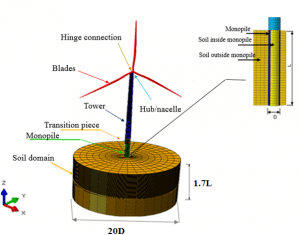
Figure 1. 3D developed model of the OWT
A modal analysis based on the developed 3D model is carried out to calculate the natural frequencies of the 10 MW DTU offshore wind turbine in parked condition. Figure 2 shows the first ten vibration modes of the OWT taking into account the soil-structure interaction. The obtained results proved that the soil-structure interaction (SSI) mainly affects the natural frequencies of the tower; whereas those of the blades remain unchanged.
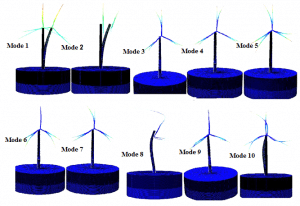
Figure 2. Vibration modes of the OWT
The suitability of the different simplified models usually employed in literature for the superstructure (Figure 3) and the soil-foundation system (Figure 4) is investigated and discussed. In addition, the effect of several parameters related to the soil-foundation system (such as the soil stiffness, the monopile geometrical properties and the transition piece height) on the OWT first natural frequency is presented and discussed.
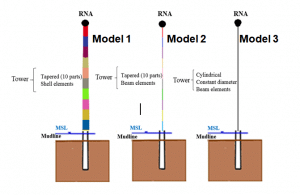
Figure 3. Simplified models of the superstructure
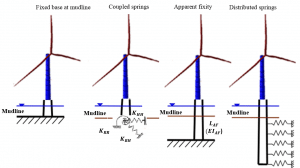
Figure 4. Simplified models of the soil-monopile system
Based on the obtained numerical results, the following conclusions may be drawn:
- The first bending modes of the tower in the side-side and the fore-aft directions are the major mode shapes of a monopile-supported OWT;
- The refined modeling of the grouted connection does not have a significant effect on the first system natural frequency;
- The first vibration frequency of the tower is significantly decreased (by 11.1%) when the SSI is considered;
- Among the different foundation models found in literature, the improved apparent fixity approach by Løken and Kaynia (2019) that considered two successive cylinders and that was tuned based on the 3D FEM-based model, resulted in the best estimate of the first natural frequency with a deviation of around 2.5%. The distributed spring model based on the modulus of subgrade reaction comes in the second place. It gives the best estimate compared to the other distributed spring models with a deviation of around 5%;
- The tuning of the different simplified foundation models (coupled springs, improved apparent fixity and the distributed spring model) based on the 3D FEM-based model proved to give a very good estimate of the first natural frequency with a maximal deviation of about 2.5%;
- Concerning the superstructure, the results proved that the representation of the RNA by a lumped mass with the corresponding mass and moment of inertia properties (cf. Figure 3, model 1) gives an estimation of the first natural frequency with a deviation of 2.5% only. Moreover, the assumption of modelling the tower with 3D shell elements (cf. Figure 3, model 1) does not improve the results significantly and thus, the assumption of using a tapered beam with the corresponding geometrical and mass properties (cf. Figure 3, model 2) is sufficient when calculating the first natural frequency;
- The natural frequency of the OWT increases with an increase in the monopile outer diameter and wall thickness. This can be explained by the increase in the stiffness of the foundation. The increase of the soil relative density results in a very small increase in the first natural frequency (of about 1.2% when the soil type changes from loose sand to a very dense sand);
- The first natural frequency of the OWT increases with an increase in the monopile embedded length, and then it becomes constant beyond a critical embedded depth (cf. Figure 5). The limit value of the embedded depth reduces with the rise in the monopile diameter and the sand relative density. The finding related to the critical embedded depth is important in design in order to avoid unnecessary over length of the monopile embedded depth.
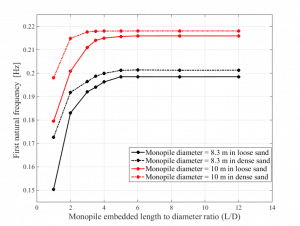
Figure 5. First natural frequency versus the monopile embedded length for two monopile diameters and installed in two sand types at a water depth of 25m
Publications and papers published
Publications
- Alkhoury P., Soubra A-H., Rey V., Aït-Ahmed M. A full three-dimensional model for the estimation of the natural frequencies of an offshore wind turbine in sand, Wind Energy, 2020.
- Alkhoury P., Aït-Ahmed M., Soubra A-H., Rey V. Finite element analysis-based mechanical model for the active vibration control of an offshore wind turbine. Submitted to Structural Control and Health Monitoring on 26 March 2021
Oral communications
- Alkhoury P., Soubra A-H., Rey V., Aït-Ahmed M., Natural frequencies of a monopile supported offshore wind turbine taking into account soil-foundation-structure interaction and incorporating soil spatial variability, 15 th EAWE PhD seminar , Nantes, October 29-31th 2019
- Alkhoury P., Soubra A-H., Rey V., Aït-Ahmed M. Natural frequencies estimation of a monopile supported DTU-10MW offshore wind turbine, 4th International Symposium on Frontiers in Offshore Geotechnics ISFOG, Austin, Texas, August 16-19, 2020
- Alkhoury P., Soubra A-H., Rey V., Aït-Ahmed M. A full three-dimensional model for the estimation of the natural frequencies of an offshore wind turbine in sand, accepted at Wind Energy, 2020
- Alkhoury P., Soubra A-H., Rey V., Aït-Ahmed M. Effect of the simplified superstructure and soil-structure interaction models on the natural frequencies of an offshore wind turbine, Proccedings of the ASME 2021 40th International Conference on Ocean, Offshore and Arctic Engineering, OMAE 2021.
- Alkhoury P., Aït-Ahmed M., Soubra A-H., Rey V. Vibration control of an offshore wind turbine, Proccedings of the ASME 2021 40th International Conference on Ocean, Offshore and Arctic Engineering, OMAE 2021.
Prospects
- Development of a tuned mass damper (TMD) for the reduction of excessive vibrations;
- Establishment of a simplified mechanical model for the soil-monopile system which can serve for fatigue computation of an OWT.

